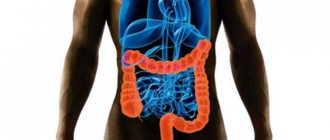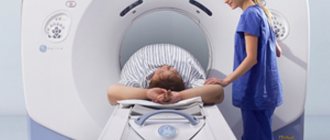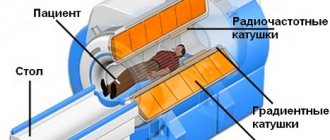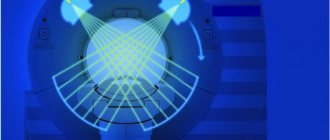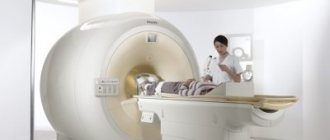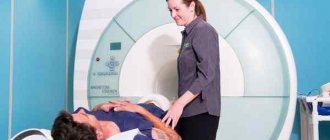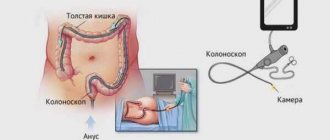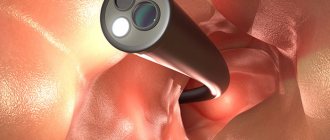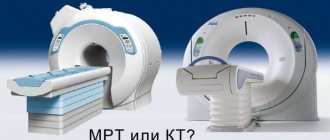Chronic inflammatory processes in the large intestine increase the risk of developing cancer pathologies. Thanks to modern diagnostic methods, it is possible to detect many diseases in this area at an early stage. Along with other manipulations, patients are often prescribed a colonoscopy. The procedure involves examining the inside of the colon using an endoscope.
As a result of the examination, changes in the inner lining of the intestine and new growths can be identified. However, many patients are very afraid of such manipulation. A more convenient diagnostic method is virtual colonoscopy. Of course, this relatively new direction raises a number of questions: what is virtual colonoscopy? How does it differ from the classic one? How do patients feel during the process?
General information about the procedure
Virtual intestinal colonoscopy is a special technique for performing computed tomography, in which a virtual three-dimensional picture of the structure of various parts of the intestinal tube is recreated using a computer. It resembles the picture that appears during a classic examination using an endoscope.
This diagnosis involves multilayer (multispiral) computed tomography, so it received the abbreviation - MSCT colonoscopy. You can also find another name for this diagnostic method - CT colonography. To carry it out, special equipment is used that generates X-rays, passes them through the body tissues, receives them back and analyzes them.
Distinctive features from other known procedures:
- The main difference between MSCT and MRI is that in the first case, the human body is exposed to X-rays, and in the second, to an electromagnetic field.
- MSCT of the intestine differs from classical endoscopy in the absence of pain and in obtaining a more accurate image. However, in the process of virtual diagnostics it is impossible to take a biopsy sample for research, which means it is also impossible to reliably confirm oncological pathology in this way.
MSCT differs from standard CT in the additional capabilities of the equipment used
Virtual colonoscopy of the intestines can colorfully show the general condition of the intestines. A colonoproctologist will be able to examine tumors, the manifestation of ulcers and erosions, as well as other changes. However, it will not be possible to assess the color of the mucous membrane and identify small formations during this procedure.
Virtual colonoscopy is most suitable for patients with low cancer risk and those who, for a number of reasons, cannot undergo the classical procedure.
Virtual colonoscopy: features of the procedure
Ionizing radiation is used not only in traditional radiography. On its basis, computer diagnostic technology has been developed, called virtual or visual colonoscopy. This method allows for a targeted examination of all structures of the large intestine, which makes it possible to detect even complex pathological disorders in its functioning, including oncological processes. Screening requires special equipment and trained diagnosticians who can interpret the scans obtained.
Indications and contraindications
Most often, virtual colonoscopy is used to search for polyps and other pathological formations of the colon.
A computed tomography scan of the intestine may be prescribed in the following cases:
- chronic inflammatory processes in the gastrointestinal tract;
- suspicion of cancer;
- patients over 40 years of age;
- patients with ulcerative lesions;
- with frequent digestive disorders without objective reasons;
- for frequent abdominal pain of unknown origin;
- to detect the source of intestinal bleeding.
The main contraindication to such diagnostics is carrying a child. For pregnant women, any radiation, even in small doses, is not recommended due to the increased risk of impact on intrauterine development.
Already on the day of the scheduled procedure, the patient may be denied it in the following cases:
- acute stage of acute respiratory infections or acute respiratory viral infections;
- "acute stomach";
- respiratory or heart failure;
- general poor health of the patient, fever, weakness;
- Ischemic colitis or peptic ulcer was detected.
Patients at risk of developing colon cancer should undergo virtual colonoscopy at least once every 5 years.
Alternative Colonoscopy Methods
If a computer study is contraindicated for the patient or cannot be performed for other objective reasons, alternative procedures are prescribed:
- Endoscopic colonoscopy. It is carried out invasively with the introduction of a thin hose, at the tip of which there is a miniature camera.
- Sigmoidoscopy. Not the entire length of the colon is examined, but only its lower part if abnormalities in this area are suspected.
- Irrigoscopy. It also involves the use of traditional X-ray equipment. Before the session, a coloring solution is injected into the intestinal cavity, which serves as a contrast in the resulting scans.
Another most informative research option is magnetic resonance imaging. Due to its high cost (compared to classical diagnostic techniques), MRI is prescribed secondarily if all other methods do not give correct results.
Advantages and disadvantages of the procedure
Advantages of MSCT:
- The procedure does not involve inserting instruments into the patient's intestines through the anus.
- The risk of penetrating damage to the colon during MSCT is many times less than during conventional colonoscopy.
- It is a priority manipulation for patients with problems with blood clotting and severe respiratory failure.
- It is much easier to tolerate by patients and does not require the use of sedative anesthesia.
- During the process, you can examine other organs of the abdominal cavity and pelvis.
Weaknesses of CT colonography:
What to do when your stomach hurts after a colonoscopy
- By distending the intestines before going into the scanner, there is a small risk of damage to the intestines.
- In one procedure, the patient receives a dose of radiation that is the same as from background radiation for 1 year and 8 months.
- It is technically difficult to perform the manipulation in patients who are obese.
- This is a purely diagnostic procedure. If a polyp is detected, you will still have to do a classic colonoscopy.
Computer diagnostics cannot completely replace invasive colonoscopy.
What is CT colonoscopy?
Computed tomography (CT) is a non-invasive test that allows doctors to look “inside” a patient’s body.
A tomograph (a special X-ray machine) receives a large number of images (so-called slices), which are processed by a computer and displayed on a monitor screen or printer.
Computed tomography provides high-quality images of many internal organs, bones and blood vessels.
Virtual colonoscopy is a special type of computed tomography that examines the large intestine (colon - in Latin). Conventional colonoscopy (not virtual) is an endoscopic diagnostic method in which the endoscope is inserted directly into the colon.
Stages of the procedure
Depending on the equipment model, the process may take different times. On average, the examination lasts about 20 minutes. A virtual colonoscopy is done as follows:
- The first stage is the injection of air into the intestines, which should straighten the intestinal walls. This manipulation is performed with the patient lying down on the couch. A special tube or bulb can be used.
- After this, the patient is placed in the scanner. To take pictures in different projections, the equipment rotates around the patient.
- The patient must listen carefully to the doctor, who will supervise his actions and warn him about the need to change his position or hold his breath.
- At the end of the procedure, excess air will be removed from the intestines using a gas tube.
- The patient will receive the results of the study within an hour. If desired, this can be a disk or printed images.
In the process, X-rays that pass through the patient's body are captured by a sensor and further processed by a computer. One revolution of the equipment around the patient is called a “slice.” In simple terms, the procedure is reminiscent of cutting bread into pieces.
About a thousand images can be taken during the procedure
Benefits of virtual colonoscopy
The technical basis of the research is a tomograph - a hardware installation that generates a field of X-rays. Despite the use of an X-ray field, there is no need to fear adverse consequences, since the effect of radiation on tissue cells is minimized to the maximum safe values. The technique belongs to the class of non-invasive research methods, so at the time of scanning the patient does not feel pain or discomfort, unlike traditional contact colonoscopy.
The main advantage of the technology is its accuracy. Scanning of the abdominal area is carried out layer by layer in transverse and longitudinal projection. As a result of a colonoscopy, a diagnostic specialist is able to examine the scans from different angles, zoom in on abnormal areas and make a detailed description.
Preparation for the procedure
Before undergoing a virtual colonoscopy, the patient should pay special attention to the preparation:
- During a preliminary conversation with the doctor, the patient must inform about all chronic diseases and medications taken on an ongoing basis. It is especially necessary to indicate if there are serious pathologies of the cardiovascular system, kidneys or liver.
- Before a virtual colonoscopy, you will need to first do an X-ray examination of the abdominal organs.
- 7-10 days before diagnosis, the patient will be advised to give up medications that contain acetylsalicylic acid and its derivatives.
- 48 hours before the scheduled procedure, you should adjust your diet. You should exclude from your diet any foods that may contribute to increased flatulence (milk, legumes, brown bread, carbonated drinks). It is better these days to give preference to fermented milk products, fish, and lean beef.
- You are allowed to have breakfast 24 hours before the examination, after which you can only drink tea and still water.
- The intestines should be cleansed especially carefully, since insufficient cleansing can negatively affect the results. To properly cleanse the intestines, an enema should be given the evening before the examination and in the morning on the day of the colonoscopy.
In the evening, it is recommended to cleanse the intestines twice, 1 hour apart. The best time for this is after 19:00. At least one and a half liters of liquid should be administered at a time. It is believed that the intestines are fully cleansed if clean water comes out during bowel movements. In addition to enemas, some resort to cleansing the intestines with the help of drugs: Fortrans, Duphalac, Flit.
Some patients decide to have a virtual colonoscopy on their own, without prescribing a proctologist. But in this case, with the results of the examination, it is still worth contacting a specialist to make the correct diagnosis.
Where they make it, prices
Computer colonoscopy is performed in many clinics in the Russian Federation that have equipped specialized rooms. The examination is carried out using the latest modern equipment, which is not available in every medical institution. Despite this, virtual colonoscopy in Moscow is offered at more than 300 addresses of private and public medical centers. The price varies depending on the prestige of the clinic and the professionalism of the specialists. On average, it starts from 8,000 rubles and can be much higher in elite medical centers. The procedure can be completed free of charge if you have a referral and compulsory medical insurance.
Virtual colonoscopy is a young innovative method of examination in proctology. Its obvious advantages (non-invasiveness, painlessness, accuracy) make it possible to increasingly introduce examination into the list of routine procedures and increase the level of examination. The disadvantages of computer diagnostics are insignificant and are compensated by additional traditional colonoscopy to clarify the diagnosis. The basis for success is the early diagnosis of dangerous intestinal diseases, an integrated approach to the methods of examining the patient and the implementation of the prescribed recommendations.
Source
Patient reviews
This direction in diagnostics is relatively new, so patients are actively looking for reviews from those who have already done this manipulation.
Natalya, 34 years old: “When I was prescribed a virtual colonoscopy, I was terribly afraid. I found few reviews, but they seemed optimistic. Let me note right away that the procedure is quite comfortable. I was more exhausted during the preparation process when I did several enemas. And already in the office itself the discomfort was only from forcing air into the intestines. The scanning itself in my case lasted 10 minutes. Afterwards I felt a little uncomfortable in my stomach from the gases. No pathologies were found in my intestines, but they did find a cyst on the ovary. I don’t regret spending money on such an examination.”
Vladimir, 43 years old: “I previously had to do a regular colonoscopy. This is a real nightmare. But now you can forget about those torments. Modern diagnostics are very gentle, I practically rested during the process. The wait for results is also short. Everything is ready on the same day in a couple of hours. I was examined, prescribed treatment and sent home. It cost me a pretty penny, but it was worth it. I highly recommend this examination.”
It is worth noting that this type of diagnostics has a high cost, however, it attracts many for its safety and lack of pain during the process. However, if a specialist insists on a classic colonoscopy, then you should listen to him. In each specific case, the attending physician can select a priority diagnostic method.
How is it carried out?
To ensure the reliability of the study data, it is necessary to follow certain doctor’s recommendations before and during the procedure. Proper preparation is an important condition for a highly informative examination. We will talk in detail about the preparatory activities in a separate article.
Virtual research has a number of features, which will be discussed below.
Progress of the procedure
Colonoscopic examination begins with the insufflation of gas into the intestines with nitrogen elements with reduced absorption. During this manipulation, patients may experience cramping pain or unpleasant discomfort. Instead of atmospheric air, carbon dioxide can be used, which passes through bilayer membranes better and practically does not provoke unpleasant sensations. For the reliability of the study, it is necessary to introduce up to 3 liters of carbon dioxide.
The procedure involves 4 main stages:
- The patient is helped to sit on the couch on his side with his knees tucked to his chest. The anus is treated with an antiseptic, Vaseline and lidocaine liniment.
- A tip is inserted into the rectal opening through which air or carbon dioxide is injected. At the end of the stage, the patient is turned onto his back and gas is continued until discomfort occurs.
- The patient is placed in a tomograph, the degree of distension of the lumens of the intestinal tract is determined (if necessary, a certain volume of gas is added).
- Scanning is carried out in various projections to examine all possible deformations of the mucous membranes.
During scanning, the device rotates around the patient's torso, and the resulting signal is controlled by a computer system. The denser the tissue in the patient's body, the lighter the image on the screen. How a colonoscopy is performed in a standard way can be found in a separate article.
On a note ! After the end of the study, the discomfort completely disappears, but it also happens that excess gas is not completely eliminated. In this case, patients are advised to take a long walk and take Espumisan.
Research time
The total duration of the study does not exceed 5 minutes, excluding preparation and gas administration. If a contrast agent is administered, the time can be increased to 10 minutes. After the procedure with contrast, it is recommended to stay in the clinic for about an hour to avoid allergic reactions to the contrast components.
After the study, the result cannot be obtained immediately “on the spot”. Usually it takes up to 3 days to decrypt. The result is issued in written form (description) and on disk media.
Technique
Considering the minimally invasive nature of the method and the absence of the need for anesthesia, no special preparation is required for the study. However, the intestines should be prepared. A few days before the procedure, patients are advised to follow a diet similar to the diet before a colonoscopy (light, non-calorie foods and drinks).
On the eve of the examination, the intestines are cleared of feces using an enema or medications: Lavacol for colonoscopy or Flit for cleansing the intestines before colonoscopy and other analogues.
Manipulative diagnostic algorithm
Before entering the diagnostic room, the patient undresses completely, removes all metal jewelry (jewelry, watches), and leaves other items in the locker room.
Then the following actions occur:
- Laying on the couch in the required position (on the stomach, on the side or on the back);
- Treating the anus with an antiseptic;
- Injection of air atmospheres to straighten the intestinal sections;
- Moving the patient into the scanner;
- The breath is held and a picture is taken (then, at the request of the doctor, the patient performs a similar action).
If, after pumping air, a feeling of severe pain occurs, then this should definitely be reported. The doctor will give you an injection with an antispasmodic solution. During the images, doctors are outside the room, but have the opportunity to observe the patient and communicate with him through a microphone.
An experienced radiologist will describe the resulting images.
Based on the results of the study, the data obtained is assessed:
- blackouts,
- suspicious areas of mucous membranes,
- erosive tissue changes,
- tumor-like neoplasms.
Deviations from the norm are recorded. Based on the description data, the doctor prescribes further tactics for managing the patient.
The quality of interpretation depends not only on the technical equipment of the office and the professionalism of the doctor, but also on the degree of preparedness of the patient for the study.
Main indications for use
The main indications for virtual colonoscopy include:
- Irregular bowel movements and long-term chronic constipation.
- Discharge of bloody contents from the rectum.
- Previously identified benign and malignant neoplasms, as well as polyps in the intestinal area.
- Chronic pain in the umbilical, right or left iliac region.
- Spontaneous causeless decrease in hemoglobin levels in the blood.
Virtual colonoscopy is especially relevant for patients with suspected single or multiple intestinal polyps. Thanks to this diagnostic option, it is possible not only to identify pathological neoplasms, but also to determine their structure.
Important! In addition to the conditions mentioned, regular virtual colonoscopy is indicated for people who have close relatives who have previously been diagnosed with cancer of the upper intestine or rectum.
Advantages and disadvantages of the study
| Advantages | Flaws |
|
|
The possibility of conducting a study with contrast can be attributed to both advantages and disadvantages. In the first case, the information content and accuracy of the diagnostic manipulation increases, in the second, intravenous administration of a contrast agent can lead to the development of a severe allergic reaction. Also, this type of study is prohibited in persons with impaired renal function.
In general, standard fibrocolonoscopy is considered more informative. With its help, the doctor independently examines the intestinal mucosa, removes polyps and other small tumors, and stops bleeding by “cauterizing” or “suturing” the vessels. The main advantage of the method is a biopsy (taking a piece of mucous membrane) with further histological analysis of the collected tissues. This makes it possible to identify the presence of chronic inflammation or determine the degree of malignancy of the tumor.
Virtual colonoscopy is used to confirm colorectal cancer (colon cancer), polyposis and chronic intestinal ulcers. The technique is in demand for patients with contraindications to endoscopic examination.
